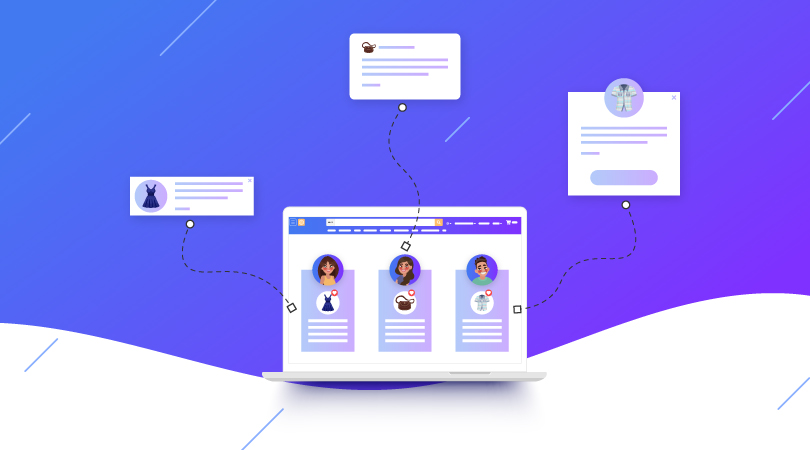Today, advertising is one of the challenging tasks to perform in marketing. Even carefully designed campaigns can usually fall short of desired goals for no obvious reason. Reaching an audience is simple today, but targeting the right audience needs practice. Marketers can quickly reach the wrong audience or fail to convey the correct message to the right audience. Thus we can make it work with the help of Behavioral Targeting.
With the rise of technology, Marketers employ several methods to make sure that the right message reaches the right individual at the right time. Progress in behavioral tracking and powerful datasets enabled advertisers to boost conversion rates beyond online and offline campaigns. According to the stat, campaigns that utilize behavior tracking and behavioral targeting are generating incredible results.
Let’s move forward to understand what it is and how it works.
What is behavioral targeting?

Behavioral targeting is an effective marketing strategy that applies historical behavior to personalize the ads as per consumer preference.
Historical behavior worked as a source that can be accumulated through powerful datasets. And these data sets show how audiences behave. Marketers can then apply this to design ads and campaigns that meet each consumer’s actual behavior.
Behavioral targeting requires building up a comprehensive user profile and delivering better messaging at the right time. It narrows down the possibility of advertisers delivering inappropriate ads and helps them to expand advertising campaign KPIs.
What are the benefits of behavioral targeting
Behavioral targeting is a compelling marketing tool that has been rooted in the modern, data-centric world we live in. But it isn’t all about utilizing numbers and tech. Behavioral Targeting renders value to both advertisers and consumers.
Advertiser benefits:
1. Increased engagement for advertisers
Knowing consumer habits encourages advertisers to recognize audiences that have been involved with specific products or touchpoints. It also assists in identifying audiences that are at the right time or behavior for a particular campaign. Targeting users with no behavioral intent or brand awareness will restrict engagement. Applying behavioral targeting will improve the number of critical metrics, such as clicks or conversions.
2. Matching consumer needs with creatives and messaging

Personalized messaging translates more users and eventually reduces the wastage of the amount on the ad. Relevant ads are much more prone to move consumers along the purchase funnel than generic ads that are not personalized. Ads that regulate a consumer’s previous behavior are much more likely to convert than ones that don’t.
3. Improving the bottom line
Every advertiser wants to get the best possible return on investment on their campaigns. Presenting ads that meet with audiences’ previous behavior is more likely to make conversions than generic ones. Companies can see a surge in new business with behavioral targeting, repeat customers, engagement, and other key metrics.
Consumer benefits
1. An enhanced ad experience
Consumers aren’t always intent on giving up their data. But they also dislike ads that aren’t appropriate or ads where the experience is unengaging. That’s why, when surveyed, more consumers prefer personalized advertising, and personalization eventually enhances their experience.
2. Better efficiency
Ads can be a fast route to purchase, presenting a fast way of identifying the best product for their obligations without a long search process. This improves consumers’ efficiency, enabling them to get to storefronts quickly and get the most relevant products rapidly.
3. Awareness of new products
By seeing ads personalized to them, consumers remain to keep up to date with new products that intrigue them. Retargeting based on behavior can also assist in completing purchases that a user was distracted from.
Publisher
Behavioral targeting not only serves the advertiser and the consumer but also helps the publisher. These publishers employ ad monetization as a revenue stream; the ads mustn’t be unrelated to the user as it might diminish engagement with their product, app, or publication.
How does behavioral targeting work?
The method of behavior-based targeting on the highest level comprises gathering information about a user or a person and then presenting ads that match this information.
Accumulating information can be performed in many ways, and it can come from many different sources. Usually, a data management platform (DMP) is used to aggregate this information for advertisers.
Here are some common data sources that are used for behavioral targeting:
- CRM
- Apps
- Websites
- Marketing systems
- 3rd party data providers
These sources render a huge variety of data that includes:
1. Website cookie data
Data on how users behave and communicate with websites is a valuable way of behavioral segmentation. Users spend a lot of time browsing the web, so the information is rich – pages visited, for how long, in which areas. Therefore these insights can give a lot of information that is useful to boost engagement and conversions.
2. Mobile device data

Cookies also work on mobile devices. Knowing the potential customer’s behavior on a mobile device can assist in understanding which format and which message could work best in an advertising campaign.
These web-based insights can be consolidated with social signals, check-ins, and mobile purchases to understand the best way to target audiences.
3. Geographic location
Anonymized location can be remarkably valuable for advertisers. Particularly when specific and precise. Since the early days of midstream datasets, device behavior can be carefully tracked to build up detailed behavior profiles that can build powerful, behavioral-based segments for advertising.
4. Subscription data
Businesses that have a log-in system expect users to enter details and information about themselves. These fields can assist in understanding the users, with address, interests, and contact details help with behavioral targeting.
5. Demographics

DMPs and other marketing software can collect large amounts of demographic segmentation information, such as age ranges, interests, and gender, to create a detailed audience profile. This process usually works without using any individual’s personal information, but these ranges are utilized to design campaigns that can interact more personally with audiences.
Wrapping it up
In this blog, we have seen how customers’ behavior helps marketers to design ads that can boost conversions. Therefore if you want to engage and retain customers then apply behavioral targeting in your business.





